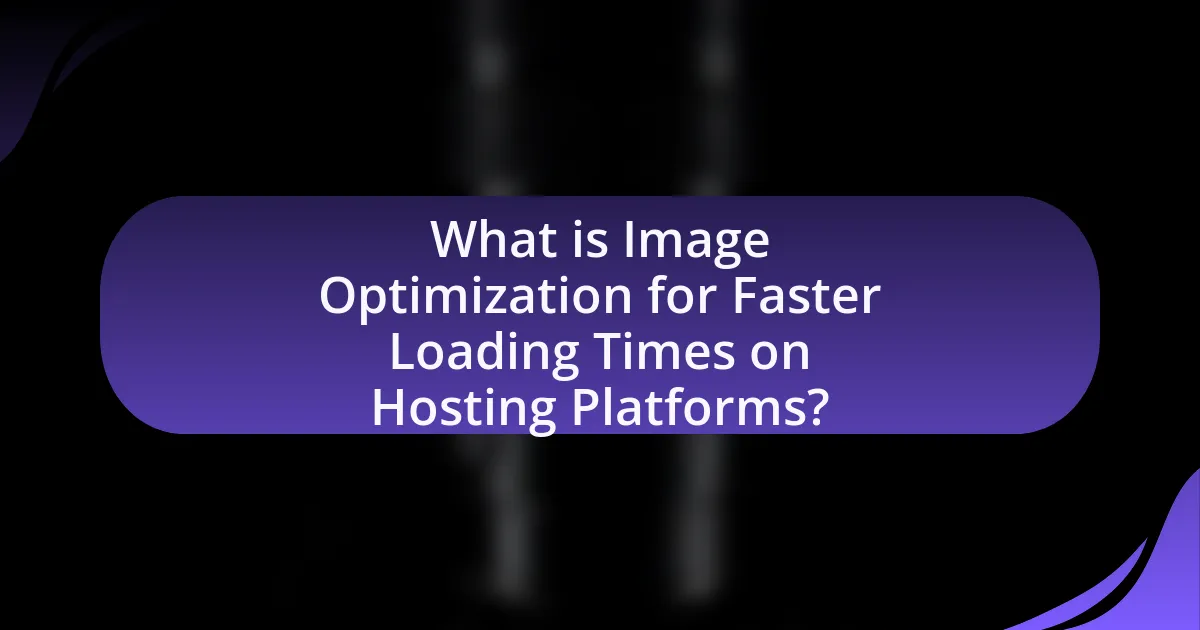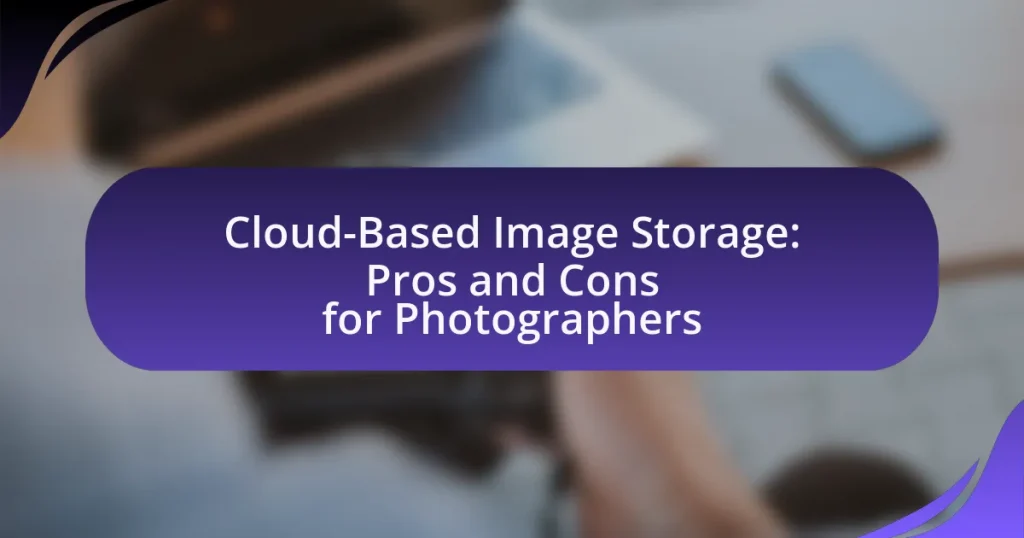Image optimization for faster loading times on hosting platforms is a critical process that involves reducing image file sizes without compromising quality, thereby enhancing website performance. This article covers the impact of image optimization on website speed, user experience, and search engine rankings, highlighting key metrics for measuring loading times and common techniques for effective optimization. It also discusses the importance of selecting appropriate file formats, implementing responsive design, and utilizing various tools for image compression. Additionally, the article addresses troubleshooting tips for slow-loading images and best practices for maintaining optimized images to ensure optimal website performance.
What is Image Optimization for Faster Loading Times on Hosting Platforms?

Image optimization for faster loading times on hosting platforms involves reducing the file size of images without sacrificing quality, thereby enhancing website performance. This process typically includes techniques such as compressing images, using appropriate file formats (like JPEG for photographs and PNG for graphics), and implementing responsive images that adapt to different screen sizes. According to Google, optimized images can reduce page load times significantly, improving user experience and potentially increasing search engine rankings.
How does image optimization impact website performance?
Image optimization significantly enhances website performance by reducing file sizes, which leads to faster loading times. When images are optimized, they consume less bandwidth and require less time to download, resulting in improved user experience and lower bounce rates. Studies indicate that a one-second delay in page load time can lead to a 7% reduction in conversions, highlighting the critical role of image optimization in maintaining user engagement and driving sales. Additionally, optimized images can improve search engine rankings, as page speed is a factor in search algorithms, further contributing to overall website performance.
What are the key metrics for measuring loading times?
The key metrics for measuring loading times include Time to First Byte (TTFB), First Contentful Paint (FCP), Largest Contentful Paint (LCP), and Total Blocking Time (TBT). TTFB measures the time taken for the server to respond to a request, indicating server performance. FCP tracks the time it takes for the first piece of content to appear on the screen, reflecting user experience. LCP measures the time it takes for the largest visible content element to load, which is crucial for perceived performance. TBT assesses the amount of time that a page is blocked from responding to user input, highlighting responsiveness. These metrics are essential for understanding and optimizing web performance, as they directly impact user satisfaction and engagement.
How do images contribute to overall page load speed?
Images significantly impact overall page load speed due to their file size and format. Large image files can slow down loading times, as they require more bandwidth and processing power to display. For instance, unoptimized images can account for up to 60% of a webpage’s total weight, leading to longer loading times and potentially higher bounce rates. Compressing images and using appropriate formats, such as JPEG for photographs and PNG for graphics, can reduce file sizes without sacrificing quality, thereby enhancing page load speed.
Why is image optimization important for user experience?
Image optimization is crucial for user experience because it significantly enhances website loading speed and performance. Faster loading times lead to lower bounce rates; studies show that a one-second delay in page load time can result in a 7% reduction in conversions. Additionally, optimized images improve mobile responsiveness, ensuring that users on various devices have a seamless experience. According to Google, 53% of mobile users abandon sites that take longer than three seconds to load, highlighting the importance of image optimization in retaining visitors and improving overall satisfaction.
How does loading speed affect user engagement?
Loading speed significantly impacts user engagement, as faster loading times lead to higher user retention and interaction rates. Research indicates that a one-second delay in page load time can result in a 7% reduction in conversions, highlighting the direct correlation between speed and user behavior. Furthermore, studies show that 53% of mobile users abandon sites that take longer than three seconds to load, demonstrating that slow loading speeds can deter users from engaging with content.
What are the consequences of slow-loading images?
Slow-loading images lead to increased bounce rates and decreased user engagement. Research indicates that 53% of mobile users abandon sites that take longer than three seconds to load. This delay can negatively impact a website’s search engine ranking, as page speed is a ranking factor for Google. Additionally, slow-loading images can result in a poor user experience, leading to lower conversion rates and reduced customer satisfaction.
What are the common techniques for optimizing images?
Common techniques for optimizing images include compression, resizing, and format selection. Compression reduces the file size without significantly affecting quality, with tools like JPEG and PNG compression algorithms achieving this effectively. Resizing images to the exact dimensions needed for display prevents unnecessary data from being loaded, which enhances loading speed. Additionally, selecting the appropriate file format—such as using JPEG for photographs and PNG for images with transparency—ensures optimal quality and size balance. These techniques collectively contribute to faster loading times on hosting platforms, improving user experience and site performance.
How does compression work in image optimization?
Compression in image optimization reduces the file size of images while maintaining acceptable quality. This process involves algorithms that eliminate redundant data, either through lossless compression, which retains all original data, or lossy compression, which removes some data deemed less critical for visual fidelity. For example, JPEG uses lossy compression to significantly decrease file sizes by approximating colors and reducing detail in less noticeable areas, achieving compression ratios of up to 90% without a substantial loss in perceived quality. This reduction in file size leads to faster loading times on hosting platforms, improving user experience and potentially enhancing search engine rankings.
What formats are best for web images?
The best formats for web images are JPEG, PNG, and WebP. JPEG is ideal for photographs due to its efficient compression and ability to maintain quality at smaller file sizes. PNG is suitable for images requiring transparency and high detail, as it supports lossless compression. WebP offers superior compression techniques, resulting in smaller file sizes while maintaining quality, making it increasingly popular for web use. These formats are widely supported across browsers and contribute to faster loading times, which is crucial for optimizing images on hosting platforms.
How can you implement image optimization on hosting platforms?
To implement image optimization on hosting platforms, utilize techniques such as compression, resizing, and format selection. Compression reduces file size without significantly affecting quality, which can be achieved using tools like TinyPNG or ImageOptim. Resizing images to the appropriate dimensions for their display context prevents unnecessary data from being loaded. Additionally, selecting modern formats like WebP can further decrease file sizes while maintaining quality. According to Google, using optimized images can improve page load speed by up to 80%, enhancing user experience and SEO performance.
What tools are available for image optimization?
Tools available for image optimization include TinyPNG, ImageOptim, and Adobe Photoshop. TinyPNG uses smart lossy compression techniques to reduce file size while maintaining image quality, making it suitable for web use. ImageOptim is a Mac application that compresses images without losing quality, ideal for optimizing images before uploading to websites. Adobe Photoshop offers advanced features for image resizing and saving in optimized formats, allowing users to control quality and file size effectively. These tools are widely recognized for their efficiency in enhancing image loading times on hosting platforms.
How do you choose the right hosting platform for optimized images?
To choose the right hosting platform for optimized images, prioritize platforms that offer built-in image optimization features, such as automatic compression and responsive image delivery. These features enhance loading times and improve user experience. For instance, platforms like Cloudinary and Imgix provide real-time image optimization, which can reduce image sizes by up to 80% without significant loss of quality. Additionally, consider the platform’s Content Delivery Network (CDN) capabilities, as CDNs can distribute images across multiple servers globally, further speeding up access times. Research indicates that websites utilizing CDNs can experience a 50% reduction in load times, making them a crucial factor in selecting a hosting platform for optimized images.
What are the best practices for maintaining optimized images?
The best practices for maintaining optimized images include using the appropriate file format, compressing images without significant quality loss, and implementing responsive images. Using formats like JPEG for photographs and PNG for graphics ensures the best quality-to-size ratio. Compression tools, such as TinyPNG or ImageOptim, can reduce file sizes by up to 80% while preserving visual fidelity. Additionally, employing responsive images through HTML attributes like “srcset” allows images to adapt to different screen sizes, enhancing loading times and user experience. These practices collectively contribute to faster loading times, which is crucial for website performance and user retention.
How often should you review and update your images?
You should review and update your images at least once every six months. Regular reviews ensure that images remain relevant, high-quality, and optimized for faster loading times, which is crucial for user experience and SEO. According to a study by Google, page load time significantly impacts user engagement, with a one-second delay potentially reducing conversions by 20%. Therefore, consistent updates not only enhance visual appeal but also improve site performance and user retention.
What role does responsive design play in image optimization?
Responsive design plays a crucial role in image optimization by ensuring that images are appropriately sized and loaded based on the device’s screen dimensions. This approach minimizes loading times and enhances user experience by delivering images that match the resolution and size of the user’s device, thereby reducing unnecessary data usage. For instance, using techniques like CSS media queries and the HTML “srcset” attribute allows web developers to serve different image sizes for different devices, which can lead to faster loading times and improved performance metrics. Studies show that optimized images can reduce page load times by up to 50%, significantly impacting user engagement and retention.
What troubleshooting tips can help with image loading issues?
To resolve image loading issues, first check the internet connection to ensure it is stable and fast enough for loading images. A slow or unstable connection can significantly delay image loading times. Next, clear the browser cache, as accumulated data can hinder the loading process. Additionally, verify that the image file format is supported by the browser; common formats include JPEG, PNG, and GIF. If images are hosted on a server, ensure that the server is operational and not experiencing downtime, as this can prevent images from loading. Lastly, inspect the website’s code for errors, such as broken links or incorrect file paths, which can also impede image loading.
How can you identify and fix slow-loading images?
To identify and fix slow-loading images, use tools like Google PageSpeed Insights or GTmetrix to analyze image load times. These tools provide specific metrics and recommendations for optimization. For instance, they may suggest compressing images, converting them to more efficient formats like WebP, or reducing their dimensions to improve loading speed. According to Google, images can account for up to 70% of a webpage’s load time, making their optimization crucial for overall performance.
What are the common pitfalls to avoid in image optimization?
Common pitfalls to avoid in image optimization include using uncompressed images, neglecting to choose the right file format, and failing to implement responsive images. Uncompressed images can significantly increase loading times, as they take up more bandwidth; for instance, a JPEG file can be compressed to reduce its size without a noticeable loss in quality. Choosing the wrong file format can also hinder optimization; PNGs are better for images with transparency, while JPEGs are more suitable for photographs. Lastly, not using responsive images can lead to poor performance on different devices, as images may not scale appropriately, resulting in longer loading times.



